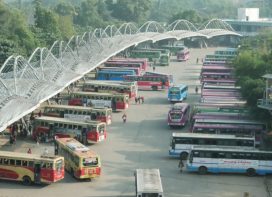A Transportation Systems Engineering perspective
It’s a common misconception that building flyovers can solve traffic congestion, but in reality, they merely shift the point of traffic congestion. Ashish Verma, Professor & Convenor and Rohit Singh Nitwal Ph.D. Scholar, IISc Sustainable Transportation Lab ( IST Lab), Department of Civil Engineering, Indian Institute of Science, Bengaluru point out that the ultimate goal of transportation planning is to create a transportation system that supports economic development, enhances quality of life, and provides safe and reliable access for all users.

L-R-Ashish Verma, Professor & Convenor and Rohit Singh Nitwal Ph.D. Scholar, IISc Sustainable Transportation Lab ( IST Lab), Department of Civil Engineering, Indian Institute of Science, Bengaluru
Flyovers are designed to follow a vehicle-centric approach, which is opposite to the core principle of the National Urban Transport Policy (NUTP), which focuses on moving people rather than vehicles. Additionally, flyovers often fail to account for the network effects and environmental impacts of transport, such as tailpipe emissions, energy requirements, and ecological impact.
When reviewing proposals for transport improvement, it’s important to ask the right questions to ensure that the solutions are effective and sustainable. One key question to ask is how much person capacity will be added per unit of investment made. Another important consideration is how much person capacity will be added per unit of space width created. Additionally, it’s important to evaluate the impact on fossil fuel consumption and air and noise pollution. By answering these questions in an unbiased manner backed by scientific data and evaluation, we can arrive at a holistic solution to urban mobility problems.
From transportation systems engineering perspective, we will see why flyover is not a long-term and unstainable mobility solution. First, we shall initially delve into the transportation planning processes and the core principles that ought to be adhered to when tackling urban mobility issues. We will then conduct a basic analysis of the proposed Sankey Road flyover and widening project in Bengaluru in terms of its potential to mitigate traffic congestion, using it as a case study.
Technical procedure of long-range urban transportation planning
Long-range urban transportation planning is a technical process that involves various steps to ensure the development of a sustainable and efficient transportation system for a city over a period of several years. Here are the basic steps involved in the technical procedure of long-range urban transportation planning:
- Establish goals and objectives: These may include improving mobility, reducing traffic congestion, increasing safety, and promoting sustainability.
- Conduct baseline analysis: The analysis of the existing transportation system includes an inventory of existing transportation infrastructure and services, traffic volume and patterns, and travel demand.
- Develop future scenarios: Based on the baseline analysis, future scenarios are developed that project population growth, land use changes, and transportation demand. These scenarios are used to develop transportation alternatives that can accommodate future transportation needs.
- Develop transportation alternatives: Based on the future scenarios. these alternatives may include improvements to public transit, roadways, pedestrian and bicycle infrastructure, and transportation demand management strategies.
- Evaluate alternatives: The evaluation is to be done using a variety of criteria such as safety, cost-effectiveness, and environmental impact. Alternatives that do not meet the goals and objectives are eliminated, and the remaining one are refined.
- Develop the preferred alternative: This is developed based on the evaluation of the transportation alternatives and is refined and optimized to meet the goals and objectives of the transportation plan.
- Implement the plan: This includes developing a detailed implementation plan, securing funding, and monitoring and evaluating the plan over time to ensure it continues to meet the goals and objectives.

Currently, city agencies in India are mostly bypassing the detailed planning process in transportation planning and jumping straight to the final step of preparing DPR for construction projects, such as building flyovers or widening roads. This approach overlooks important considerations, leading to loopholes in the planning process and ultimately failing to achieve a long-term and sustainable mobility solution for the city. The construction of such trivial projects requires significant resources, and investing such a large amount into a solution that will only last for a few years or less is problematic.
Case Study
This section presents a basic analysis of the proposed Sankey Road flyover and road widening in Bengaluru, India, with respect to traffic congestion mitigation potential as a case study.
The V/C ratio-”volume to capacity”- is a measure of traffic congestion that is commonly used in transportation planning. Capacity refers to the maximum number of vehicles that can be accommodated on a roadway or intersection while maintaining an acceptable level of service. The capacity of a roadway or intersection is affected by factors such as the number of lanes, the speed limit, the geometry of the roadway, and the presence of traffic control devices.
The V/C ratio is used to assess the level of congestion on a roadway or intersection. A V/C ratio greater than 1 indicates that the volume of traffic exceeds the capacity of the roadway or intersection, which suggests that there is likely to be congestion and delays.
Transportation planners use the V/C ratio to evaluate existing roadway conditions, forecast future traffic volumes, and assess the impact of proposed roadway improvements or changes. The V/C ratio is one of many performance measures used in transportation planning, and it is often used in combination with other measures such as travel time, delay, and level of service to assess the overall performance of the transportation system. Level of Service (LoS) and V/C ratio of Multiple Divided Urban Roads are taken from Indo-HCM for analysis. The LoS are: LoS A (V/C): <0.15, LoS B (V/C): 0.15-0.45, LoS C (V/C): 0.46-0.75, LoS D (V/C): 0.76-0.85, LoS E (V/C): 0.86-1.00 and LoS F (V/C): >1.00.
There are three options which are presented in the detailed project report (DPR) prepared by BBMP for the ‘Widening of Sankey road from Bhashyam Circle to Malleshwaram 18th Cross and Construction of Flyover along the Sankey Road in Malleshwaram Constituency’.

Option 1: 2 Lane Bi-directional fly-over along Guttahalli main road & Sankey road.
Option 2: 4 Lane Bi-directional fly-over along Guttahalli main road & Sankey road.
Option 3: 4 lane Bi-directional flyover for Bhashyam junction only and widening of Sankey road towards Malleshwaram 18th cross.
| FOUR LANE BIDIRECTIONAL | YEARS | ||||||||||
| 2022 | 2023 | 2024 | 2025 | 2026 | 2027 | 2028 | 2029 | 2030 | 2031 | 2032 | |
| TOWARDS MALLESHWARAM (V/C) (MORNING) | 0.45 | 0.51 | 0.58 | 0.65 | 0.74 | 0.83 | 0.94 | 1.06 | 1.20 | 1.36 | 1.53 |
| TOWARDS MALLESHWARAM (V/C) (EVENING) | 0.27 | 0.31 | 0.35 | 0.39 | 0.45 | 0.50 | 0.57 | 0.64 | 0.73 | 0.82 | 0.93 |
| TOWARDS PALACE ROAD (V/C) (MORNING) | 0.31 | 0.35 | 0.39 | 0.44 | 0.50 | 0.57 | 0.64 | 0.72 | 0.82 | 0.92 | 1.04 |
| TOWARDS PALACE ROAD (V/C) EVENING) | 0.26 | 0.29 | 0.33 | 0.37 | 0.42 | 0.47 | 0.53 | 0.60 | 0.68 | 0.77 | 0.87 |
| AT GRADE(V/C) for Critical section | YEARS | ||||||||||
| 2022 | 2023 | 2024 | 2025 | 2026 | 2027 | 2028 | 2029 | 2030 | 2031 | 2032 | |
| TOWARDS MALLESHWARAM (V/C) (MORNING) | 0.49 | 0.55 | 0.62 | 0.70 | 0.79 | 0.90 | 1.01 | 1.14 | 1.29 | 1.46 | 1.65 |
| TOWARDS MALLESHWARAM (V/C) (EVENING) | 0.63 | 0.71 | 0.81 | 0.91 | 1.03 | 1.17 | 1.32 | 1.49 | 1.68 | 1.90 | 2.15 |
| TOWARDS PALACE ROAD (V/C) (MORNING) | 1.07 | 1.21 | 1.37 | 1.54 | 1.74 | 1.97 | 2.23 | 2.52 | 2.84 | 3.21 | 3.63 |
| TOWARDS PALACE ROAD (V/C) EVENING) | 0.99 | 1.12 | 1.27 | 1.43 | 1.62 | 1.83 | 2.07 | 2.34 | 2.64 | 2.98 | 3.37 |
Based on the morning and evening peak-hour traffic details of 2022 provided in the DPR and forecasted traffic details till 2032 using a 13 % growth rate, V/C ratios were calculated for the above three options at the flyover and At-grade critical section. Since the DPR finalized option 3 for the construction of the flyover, below are the V/C ratios for option 3 at flyover and At-grade critical section.
The LoS is F (i.e., V/C > 1) is highlighted in red. Hence just a few years after the construction of the flyover, congestion can already be observed at the flyover and at-grade critical section. This also shows that flyovers will only shift the point of traffic congestion from one point on the road to the other. A further analysis of the proposed flyover through simulation model will help understand its network impact, as well as impact on fossil fuel consumption and tailpipe emissions, which would be presented in subsequent articles.
Transportation planning should no more be just about removing congestion points and reducing the V/C ratio but needs to take a systems approach that considers reducing total motorized VKT, reducing dependence on fossil fuels, and fixing the energy mix to renewable sources. The focus should be on making sustainable modes of transportation more attractive to use and making personal mobility modes less attractive to own and use. Flyovers, which follow a vehicle-centric approach and do not account for network effects, environmental impact, and equity, are not a solution to traffic congestion.
When reviewing transport improvement proposals, it’s crucial to consider the amount of person capacity added per unit of investment and space width, and the changes in fossil fuel consumption and air and noise pollution. Only by answering these questions with scientific data and evaluation can we arrive at a holistic solution to urban mobility problems.
The authors acknowledge interns of IST Lab, Deeba Fayaz and Junaid Sofi, BTech students from National Institute of Technology, Srinagar, for helping in the data analysis for the case study provided in the article.
 TrafficInfraTech Magazine Linking People Places & Progress
TrafficInfraTech Magazine Linking People Places & Progress
